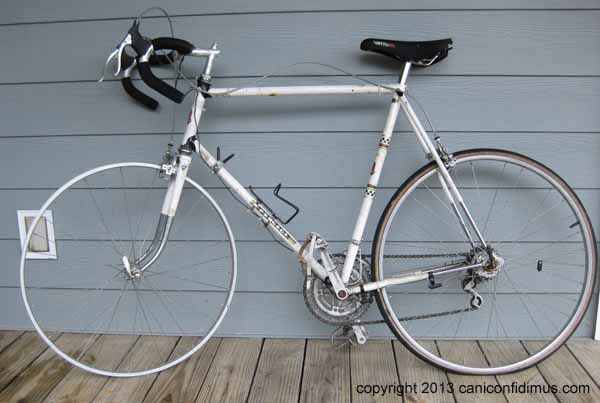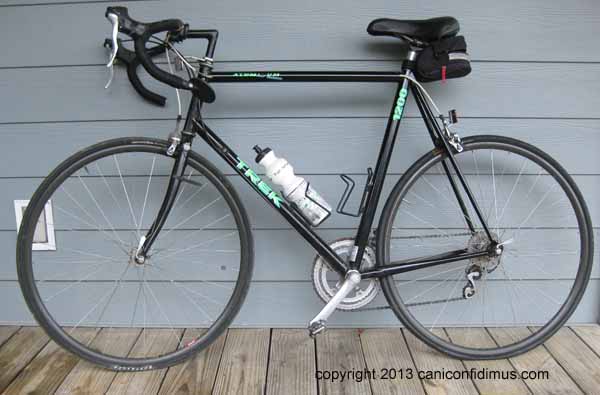When I started at Georgia State University in 1971, after the first quarter I roomed with my friend Tom in an apartment a few miles from the campus. Georgia State is in the heart of downtown Atlanta, not far from the capitol building. There is no parking anywhere near the campus. At that time, students were allowed to park in lots near the stadium, about a mile away. If you wanted to park on campus, you had to ride a bicycle. So I did. I bought a cheap, heavy 10-speed from Sears. It was about as crude as a bicycle can be, but I rode it almost every day until I graduated in 1973. I rode it rain or shine, cold or hot, in heavy traffic or light.
After graduation in the spring of 1973, I got a job as a newspaper reporter in Augusta, Ga., on The Augusta Chronicle (the “The” is part of the name). I started running then, but I still wanted to ride a bike, so I got some bicycling magazine review editions and decided on a Peugeot PX-10E. It was a nice, mid-level bike, not the cheapest and not the most expensive, not the best and not the worst. But it rated pretty highly, and I liked it. So I saved my money. That summer I found one and paid $270 for it, exactly twice my weekly salary.
Here it is.

My old Peugeot, without a front tire
This was a pretty serious bicycle at the time. It had tubular tires, also called sew-ups or glue-on tires. They were the lightest bicycle tire you could use. The tire had thin edges instead of a hard bead that holds it to the rim. It was sewn up around an inner tube that was so thin you could almost see through it. And then, since it didn’t have a bead, the tire was glued to the rim. I read that it was possible to repair a flat on one of these tires, but I never tried. I always just got a new tire and glued it on.
The seat was made of the hardest leather I have ever felt. The bicycling magazines said this was the best type of seat. They said if you rode enough, it would soften and shape itself to your own shape. I do not believe this. I soaked it in oil, pounded it with a hammer and drilled holes into it. It was still as hard as a block of wood. If I had tried to ride on that saddle long enough to soften it, I am sure I would have had serious, permanent nerve damage in my groin. I gave up and replaced it with a softer saddle.
Since it was French, it could have only French components. The derailleurs worked well enough as long as they lasted, but eventually they just sort of fell apart. Since they were French, of course a modern Japanese rear derailleur wouldn’t just bolt on. I had to jury rig it.I’ And eventually I got tired of replacing tires, so I switched the rims for clinchers, the standard type of bicycle wheel and tire that you see on virtually every bicycle today. It’s hard for me to believe now, but I actually laced the spokes to the new rim, tightened them and trued the wheels all by myself. I did a pretty good job, too.
I rode my Peugeot for a long time. When I quit the newspaper business and went back to school at Georgia Tech, I found a place to live that was only a few miles from school, and I commuted on my bike again. When I got a job in Huntsville, Al., in 1986, I brought my bike with me. When my knees started giving me problems, I started biking instead of running. At that time I rode a 20-mile course and at times actually averaged 20 mph over the course. It was nothing compared to a real bicyclist. I knew one at work who put more miles on his bike than on his car.
After riding my Peugeot for 20 years, I bought new bike. I got this Trek in about 1993.

My “new” bike
I can’t remember how much I paid for it. I’m sure it was several times what the old Peugeot cost, but I guess spending the money then just didn’t make as big an impact on me as it did in 1973.
It has an aluminum frame instead of steel. When I first rode it I was surprised at how much better it felt than the old Peugeot. I haven’t ridden since summer before last, but I’m sure when the weather gets warmer again I will pick it up. This area is very popular with bicyclists. They like climbing Fouche Gap Road, and the ride around Texas Valley is nice.
As you can see, I kept the Peugeot. I haven’t ridden it since I got the Trek, but I just can’t bring myself to get rid of it. The Trek is my current bicycle, and I’m pretty sure it will be my last. Maybe one day when I get old and decrepit and I’ll sell both of them. Or maybe not.